The biker story has fascinated filmmakers and movie fans for more than half a century, most recently in Jeff Nichols’ love letter to the 1960s motorcycle club heyday, “The Bikeriders.” Like Danny Lyon’s photo book that inspired it, the film is a series of snapshots of a horseman’s life, of the violence and destruction that often results from that lifestyle, even though the clubs to which these riders belong were initially content to help each other.
“The club begins with a mutual love and admiration for riding,” “Bikeriders” star Jodie Comer said in a recent interview with IndieWire, “but over time it becomes dark, criminal and violent.”
It’s a narrative present in many films presenting the world on two wheels, where motorcyclists are seen as vandals and terrorists who want nothing more than to disrupt the traditional way of life. Added to these films is an examination of masculinity itself and how the threat of someone tougher than you can often elicit harsh reactions.
“Because she’s on the periphery and she’s a woman, she can see what these men are avoiding and not facing, and the danger they put themselves in to appear a certain way,” said Comer at IndieWire.
This female perspective on such a harsh and virile world sets “The Bikeriders” apart from other biker films, even if it draws directly on classics like “The Wild One” for its narrative engine. In the film, watching the Marlon Brando vehicle ultimately leads Tom Hardy’s character, Johnny, to start his own club, which attracts the loyalty and hostility of Austin Butler’s character, Benny. Comer, Hardy and Butler evoke a “Challengers”-like dynamic throughout the film, with Comer and Hardy vying for Butler’s soul.
But the bad boy image of the motorcyclist isn’t the only one left on screen. In honor of this weekend’s release of “The Bikeriders,” IndieWire has compiled a list of the best motorcycle films, some of which delight in rebellion, and others that dissect that desire instead. Check out the list below.
-
“The Savage” (dir. Benedek László, 1953)
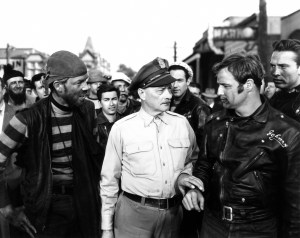
Image Credit: Courtesy of Everett Collection
What many consider the first of what would become the outlaw biker genre, “The Wild One” plays out almost like a classic western, with horseman Johnny Strabler riding into town with his gang, looking for nothing. no trouble, but ready to create some if he got into trouble. Unfortunately, that’s exactly what happens when another gang that split off from Johnny’s arrivals creates a real “this town isn’t big enough for two” vibe. After his rise in “A Streetcar Named Desire” and before “On the Waterfront,” Marlon Brando’s performance as Johnny would define a generation of brooding tough guys, as exemplified by Tom Hardy’s character in “The Bikeriders “.
-
“The Wild Angels” (dir. Roger Corman, 1966)
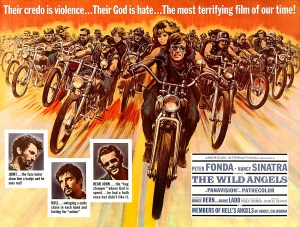
Image Credit: Courtesy of Everett Collection
Although “The Wild One” is the model biker film on this list, “The Wild Angels” should be more credited for popularizing the outlaw anti-hero. Starring Peter Fonda in what would be only his first duet with a Harley Davidson, the film serves as both a sex, drugs and violence-filled exploitation piece and an in-depth exploration of counterculture of the 60s around biker gangs. Bruce Dern is also featured as Fonda’s best friend, with his wife Diane Ladd playing his girlfriend, both facing tragic consequences due to their proclivities and thirst for freedom. In true Corman fashion, he also cast some members of the Hells Angels and Coffin Cheaters motorcycle clubs for authenticity.
-
“Easy Rider” (dir. Dennis Hopper, 1969)
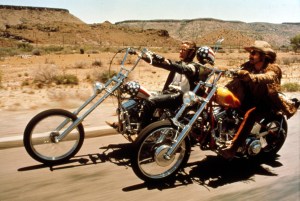
Image Credit: Courtesy of Everett Collection
Earning $60 million on just a budget of around $400,000 – provided by Roger Corman and his American Independent Pictures – “Easy Rider” opened the door to the new Hollywood, giving filmmakers the opportunity to take the reins of the process and to avoid studios that lost the sense of what the public wanted. Following bikers and drug mules Wyatt (Peter Fonda) and Billy (Dennis Hopper) as they travel the American Southwest and South with their winnings from a recent cocaine deal, the film embraced the beauty of counterculture with scenes of free and psychedelic love. journeys, but also with a sense of lost naivety that makes the climax of Wyatt and Billy’s ride all the more tragic.
-
“Any Sunday” (dir. Bruce Brown, 1971)
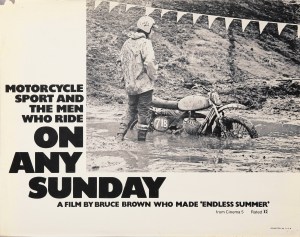
Image credit: Everett Collection/Everett Collection
Nominated for Best Documentary Feature at the 1972 Academy Awards, “On Any Sunday” reveals the world of the sport of motocross with slow-motion, high-speed inventiveness and nuanced human examinations. Produced by and starring Steve McQueen, the film also featured lesser-known riders like Malcolm Smith and David Aldana, unveiling the different personality types that each form of racing, whether motocross, desert, or road riding. at the national level, attracts. While previous films, such as “The Wild One,” depicted bikers as “bad guys,” “On Any Sunday” helped change people’s perceptions of these leather-clad daredevils.
-
“The Loveless” (directed by Kathryn Bigelow and Monty Montgomery, 1981)
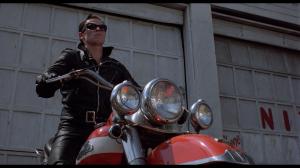
Image credit: Atlantic Release, Kathryn Bigelow and Monty Montgomery
The feature debut of Bigelow and Montgomery, the film contains specific homages to “The Wild One”, with much of the action surrounding the presence of a biker gang in a 1950s town that doesn’t want them, but also reminiscent of the exploitation era of the 60s with explosions of violence and chaos. “The Loveless” also sees Willem Dafoe in his first leading role as Johnny Strabler’s replacement, Vance, who plays more of a witness to the chaos unleashed by his gang’s presence than an actual active participant. Truly, what “The Loveless” brings to the biker movie genre is that often the presence of the outlaw becomes an excuse for “normal, law-abiding people” to unleash their inner monster.
-
“Akira” (dir. Katsuhiro Otomo, 1988)
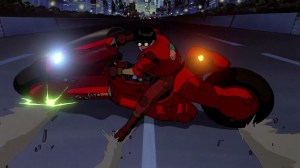
Image credit: Toho/Katsuhiro Otomo
Based on the popular 1982 manga of the same name, “Akira” is a one-of-a-kind anime and considered by many to be one of the greatest films ever made. The “Akira” slide move, shown in the image above, has inspired filmmakers like The Wachowskis, Quentin Tarantino, Jordan Peele and Christopher Nolan. Garnering a cult following through home video sales, “Akira” helped popularize the cyberpunk genre as well as the concept of adult animation. Like many great biker stories, it tells the story of two friends from the same gang who are torn apart after one of them gets into an accident. Where this changes from the traditional outlaw biker film narrative is that this story takes place in a dystopian neo-Tokyo and the accident gives the victim telekinetic powers that threaten the entire city. It’s a pulpy masterpiece, sure, but one hell of an adventure.
-
“Roadside Prophets” (directed by Abbe Wool, 1992)
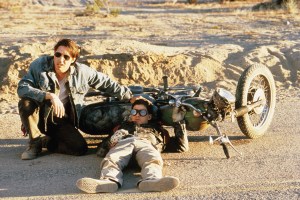
Image credit: ©New Line Cinema
A road movie along the lines of “Into the Wild,” where it’s largely populated with random connections unfolding as two riders hit the road on separate missions, together, “Roadside Prophets” clearly wants to do what “Easy Rider” did in showcasing the counterculture of the 1960s, with the slightly weirder counterculture of the 1990s. Starring John Doe of the Los Angeles punk band X and Adam Horovitz of the Beastie Boys, the film also features cameos from Flea, Timothy Leary, David Carradine and Arlo Guthrie, as well as a scene with John Cusack showcasing perhaps his wildest performance. While it doesn’t seem as hard-hitting as “Easy Rider,” it brings its own commentary to the biker genre, poking fun at the seriousness and unfortunate wisdom associated with motorcyclists.
-
“Motorcycle Journals” (directed by Walter Salles, 2004)
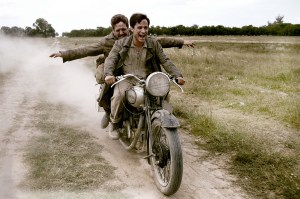
Image credit: ©Focus Films/Courtesy Everett Collection
Many will see this addition as a stretch from Nichols’ “Bikeriders” or biker films in general, perhaps due to the fact that the eponymous motorcycle, nicknamed La Poderosa (The Powerful) by Ernesto “Che” Guevara and his friend Albert Granado doesn’t even make it through most of the journey through South America that his main characters undertake at the beginning of the film. And yet, “The Motorcycle Diaries” remains on this list for explaining how Ernesto and Albert come to embrace what machines mean to many. A feeling of freedom, adventure and radicalism that gives way to a new sense of thought and being.
-
“12 O’clock Boys” (dir. Lofty Nathan, 2013)
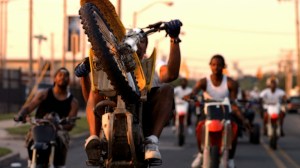
Image Credit: Oscilloscope Labs
There’s certainly a bit of exploitation in this downplayed view of Baltimore bikers and the young boys who romanticize them, but the reality Lofty Nathan seeks in his documentary is one of simplicity. At its core, “12 O’Clock Boys” is the story of a young black boy who sees a dirt bike as his path to community. While the film doesn’t delve into the nuances of the misunderstood group 12 O’Clock Boyz, it does allow their presence to serve as inspiration for the boy, who, as Nathan films, doesn’t have much else what to draw inspiration from in your current life. community. What’s fascinating about this documentary, compared to films like “The Wild One” and “The Bikeriders”, is how it shows the birth of a rebel at such a young age, while the sense of what rebellion even is still seems so abstract. , as if any act could be considered as such.